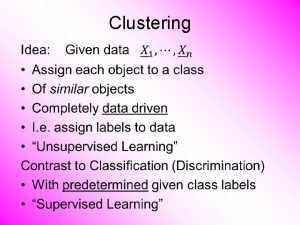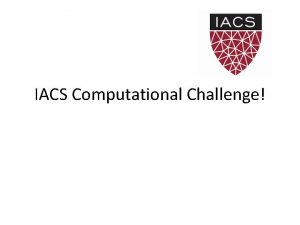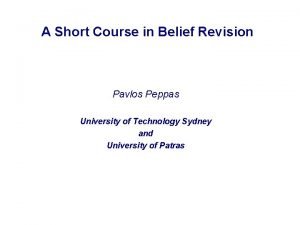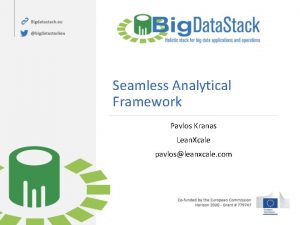Model Selection Part A Model Selection Pavlos Protopapas

















- Slides: 17

Model Selection Part A: Model Selection Pavlos Protopapas Institute for Applied Computational Science Harvard 1

Model Selection Model selection is the application of a principled method to determine the complexity of the model, e. g. choosing a subset of predictors, choosing the degree of the polynomial model etc. A strong motivation for performing model selection is to avoid overfitting, which we saw can happen when: • there are too many predictors: • the feature space has high dimensionality • the polynomial degree is too high • too many cross terms are considered • the coefficients values are too extreme (we have not seen this yet) PAVLOS PROTOPAPAS 2

Generalization Error We know to evaluate the model on both train and test data, because models that do well on training data may do poorly on new data (overfitting). The ability of models to do well on new data is called generalization. The goal of model selection is to choose the model that generalizes the best. PAVLOS PROTOPAPAS 3

Train-Validation-Test We use this to report model performance We use this to train a model We use this to select model PAVLOS PROTOPAPAS 4

Model Selection Question: How many different models when considering J predictors (only linear terms) do we have? PAVLOS PROTOPAPAS 5

Stepwise Variable Selection and Validation Selecting optimal subsets of predictors (including choosing the degree of polynomial models) through: • stepwise variable selection - iteratively building an optimal subset of predictors by optimizing a fixed model evaluation metric each time. • validation - selecting an optimal model by evaluating each model on validation set. PAVLOS PROTOPAPAS

Stepwise Variable Selection: Forward method PAVLOS PROTOPAPAS

Stepwise Variable Selection Computational Complexity How many models did we evaluate? • 1 st step, J Models • 2 nd step, J-1 Models (add 1 predictor out of J-1 possible) • 3 rd step, J-2 Models (add 1 predictor out of J-2 possible) • … PAVLOS PROTOPAPAS 8

Choosing the degree of the polynomial model Fitting a polynomial model requires choosing a degree. Degree 1 Underfitting: when the degree is too low, the model cannot fit the trend. Degree 2 We want a model that fits the trend and ignores the noise. Degree 50 Overfitting: when the degree is too high, the model fits all the noisy data points. PAVLOS PROTOPAPAS

Best model: validation error is minimum. Underfitting: train and validation error is high. Overfitting: train error is low, validation error is high. PAVLOS PROTOPAPAS 10

Exercise C. 1 11

Cross Validation: Motivation Using a single validation set to select amongst multiple models can be problematic - there is the possibility of overfitting to the validation set. It is obvious that degree=3 is the correct model but the validation set by chance favors the linear model. PAVLOS PROTOPAPAS 12

Cross Validation: Motivation Using a single validation set to select amongst multiple models can be problematic - there is the possibility of overfitting to the validation set. One solution to the problems raised by using a single validation set is to evaluate each model on multiple validation sets and average the validation performance. One can randomly split the training set into training and validation multiple times but randomly creating these sets can create the scenario where important features of the data never appear in our random draws. PAVLOS PROTOPAPAS 13

Cross Validation PAVLOS PROTOPAPAS 14

K-Fold Cross Validation PAVLOS PROTOPAPAS 15

Leave-One-Out PAVLOS PROTOPAPAS 16

Exercise C. 2 17
 Pavlos protopapas
Pavlos protopapas Pavlos protopapas
Pavlos protopapas Iliad plot diagram
Iliad plot diagram Pavlos zoubouloglou
Pavlos zoubouloglou Cibse lodgement portal
Cibse lodgement portal Karolina pelendritou
Karolina pelendritou Addition symbol
Addition symbol Unit ratio definition
Unit ratio definition Brainpop ratios
Brainpop ratios Part by part technical description example
Part by part technical description example Layout of dispense bar
Layout of dispense bar The phase of the moon you see depends on ______.
The phase of the moon you see depends on ______. Minitab adalah
Minitab adalah Far part 16 source selection
Far part 16 source selection Balancing selection vs stabilizing selection
Balancing selection vs stabilizing selection Artificial selection vs natural selection
Artificial selection vs natural selection K selection r selection
K selection r selection Natural selection vs artificial selection
Natural selection vs artificial selection




























